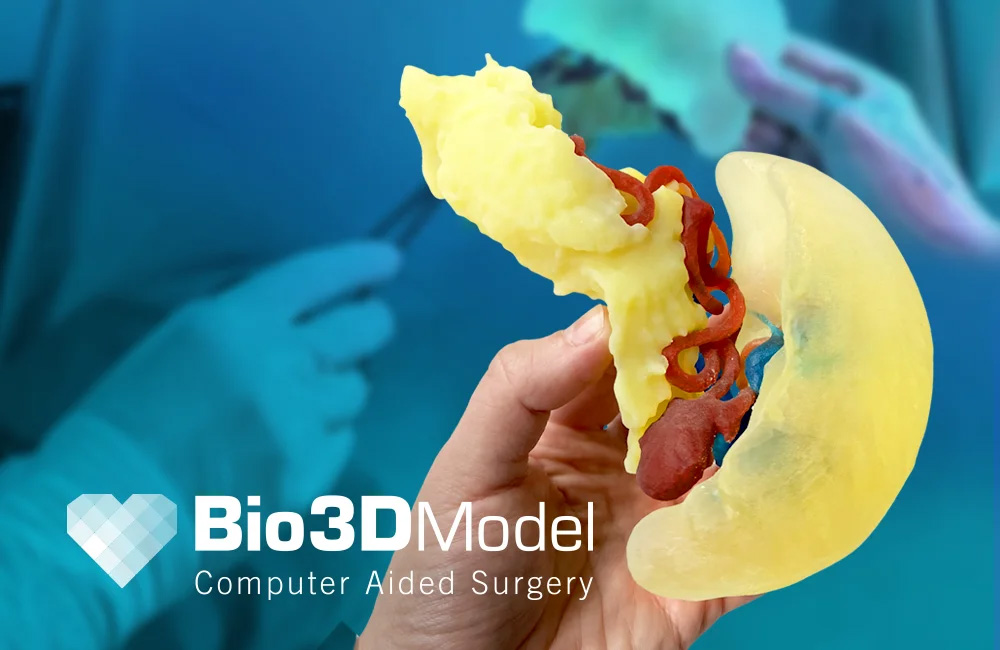Florence, April 15, 2024 – Integrating advanced technologies is proving increasingly crucial in the biomedical and healthcare sectors. Proof of this is the surgical procedure which, by using 3D printing combined with a minimally invasive laparoscopic approach, saved a young woman’s life and preserved the patient’s spleen.
The surgery was performed at San Giovanni di Dio Hospital in Florence. The 3D print by Bio3DModel, part of the SolidWorld Group, was used to create a model of the spleen specifically for the patient, which was then used in pre-surgery to precisely plan how the operation would be performed. The model included anatomical structures such as the spleen, pancreas, and splenic vessels, which provided valuable information both before and during the surgery and contributed to its successful outcome.
“Following meetings with the surgeons and having received documents including tomograms and medical examinations, we recreated an extremely faithful model of the organ before the patient’s hospitalization. Our biomedical engineering team consisting of Federica Giovannini and Paulina Socha prepared the model that included the critical points and ratios of the various anatomies, differentiated by color, needed for intraoperative guidance”stated Mr. Giovan Battista Semplici, Chairperson of Bio3DModel.
“It is often difficult to preserve the spleen in these types of cases, especially when the aneurysm almost enters the organ,” explains Dr. Emiliano Chisci, a vascular surgeon who, together with the head of General Surgery Alessandro Anastasi, and under the guidance of surgical department director Stefano Michelagnoli, conducted the surgery, in a note from the Toscana Centro Local Health Facility. “Despite this, we were able to preserve the organ by excluding a large splenic artery aneurysm.”
The surgery further demonstrates how biomedical 3D printing technology and the expertise of Bio3DModel’s technology hub in Barberino Tavernelle (Florence) provides effective support to medical teams performing complex operations. It also underlines the positive impact of integrating advanced technologies such as 3D printing into surgical practice.
3D Printing and 3D Bioprinting – This is a technology to which the SolidWorld Group added 3D bioprinting in 2023. Thanks to Electrospider, a printer that can reproduce human tissues, SolidWorld Group is able to provide support for Italian and international hospitals, private clinics, foundations and research institutes. It does so by – for the first time – simultaneously printing both the tissue support structure (made of biocompatible material using the electrospinning technique to nanometer thickness) and the cell hydrogels of a variety of human cell types. Electrospider – for which the SolidWorld Group holds the global patent – is the result of the collaboration between Bio3DModel and the E. Piaggio University of Pisa (Department of Biomedical Engineering).
Focus | The key advantages of 3D printing in surgical practice [1]
Improved visualization: the 3D model offered a realistic and detailed representation of the patient’s anatomy, facilitating a thorough understanding of the complex relationships between the splenic artery, the pancreas, and the surrounding structures.
Personalized planning: the 3D model enabled our team to tailor the surgical approach to the patient’s specific anatomy, accounting for factors such as the tortuous artery, the presence of the pancreas, and the deep location of the aneurysm.
Team collaboration: the detailed 3D model aided effective communication and collaboration between the vascular and general surgeons.
Counseling: the 3D model made it easier to communicate with the patient about their pathology and treatment and to assess the relative risks and benefits
Optimized surgical technique: thanks to a clear understanding of the patient’s unique anatomy, the medical team was able to plan and carry out a surgical technique that minimized risks and maximized the chances of a successful outcome.
[1] Source: Toscana Centro Local Health Facility
Contacts:
IR & Media Advisor TWIN Srl
Maria Di Giorgio
T: +39 3357737417
E-mail: mara@twin.services
Chiara Bortolato
T: +39 3478533894
E-mail:chiara@twin.services
Related topics:
European Small and Mid-Cap awards 2023 SolidWorld Group receives “Star of Innovation” award
Following a careful evaluation by an expert jury, the "Star...
Read more..SolidWorld 3D Bioprinters arrive in Qatar: Five-Year Distribution Agreement Signed with Orion Bostars LLC
The Doha-based Qatar agency will supply SolidWorld’s biomedical products to...
Read more..3D technology, SolidWorld GROUP reproduces a human brain with a tumor in 3D
The subsidiary Bio3DModel 3D printed an exact copy of the...
Read more..




